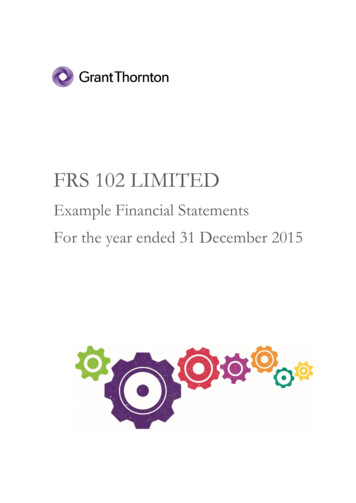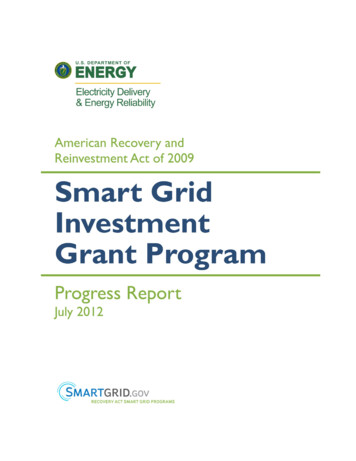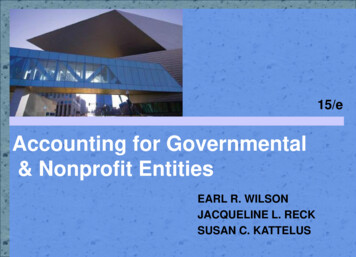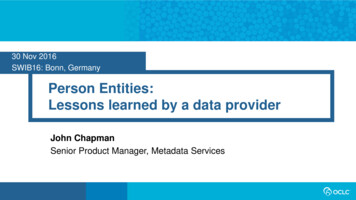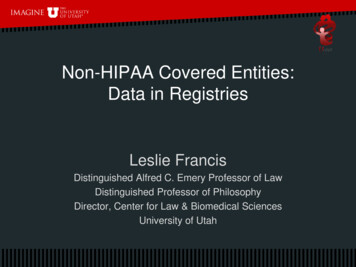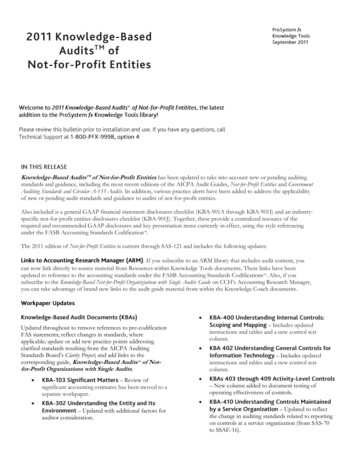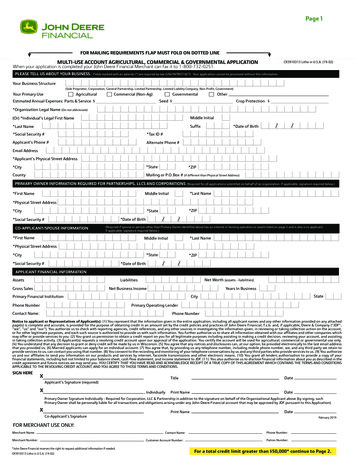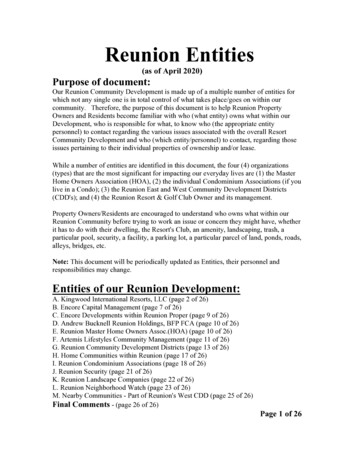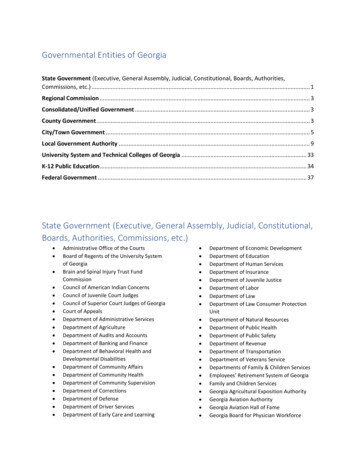
Transcription
Investment entities
Under control? A practical guide to IFRS 10 Investment entitiesFor many years, preparers and investors in the investment entity industry felt thatconsolidating the financial statements of an investment entity and its investees does notprovide the most useful information. Consolidation made it more difficult for investors tounderstand what they are most interested in – the value of the entity’s investments.The IASB were influenced by these arguments. In October2012, the IASB amended IFRS 10 to provide a limited scopeexception from the consolidation guidance for a parent entitythat meets the definition of an investment entity. The changesprovided a definition of an investment entity together withdetailed application guidance. Entities that meet the definition ofan investment entity in accordance with IFRS 10, do notconsolidate certain subsidiaries and instead measure thoseinvestments that are controlling interests in another entity (ietheir subsidiaries) at fair value through profit and loss. Thisexception does not apply to subsidiaries which provideinvestment related services to the parent entity (‘servicesubsidiaries’) which will continue to be consolidated. This is amandatory exception, not an optional one.There were a number of implementation issues identified inapplying this exception and therefore in December 2014 theIASB published amendments to the investment entity exceptionentitled ‘Investment Entities: Applying the ConsolidatedException (Amendments to IFRS 10, IFRS 12 and IAS 28)’addressing these issues. These amendments are incorporatedin the detail of this section.Practical insight – number of entities affectedMany entities that fit the investment entity definition arenonetheless not impacted by the exception to consolidationbecause their investments are not subsidiaries. Investmententities that commonly hold controlling interests includeventure capital and private equity groups, along with some‘master-feeder’ and ‘fund-of-funds’ structures. Somepension funds and sovereign wealth funds may beimpacted. Unit trust and mutual fund-type entities rarelyhold controlling interests and therefore are normally lesslikely to be affected.1.1 Definition of an investment entityThe definition of an investment entity is fundamental when determiningif the exception should be applied. It has three components,accompanied by four ‘typical characteristics’. Establishing whetheran entity meets the definition of an investment entity is the centralelement to this exception, and could require significant judgement.The definition, typical characteristics and their interactionare set out below:Definition of an ‘investment entity’ [IFRS 10.27]An investment entity is an entity that:a) obtains funds from one or more investors for thepurpose of providing those investor(s) with investmentmanagement services (investment services condition)b) commits to its investor(s) that its business purpose is toinvest funds solely for returns from capital appreciation,investment income, or both (business purpose condition)c) measures and evaluates the performance ofsubstantially all of its investments on a fair value basis(fair value condition).Typical characteristics [IFRS 10.28]In assessing whether it meets the definition, an entity shallconsider whether it has the following typical characteristicsof an investment entity:a) it has more than one investmentb) it has more than one investorc) it has investors that are not related parties of the entityd) it has ownership interests in the form of equity orsimilar interests.In October 2012, the IASB amendedIFRS 10 to provide a limited scopeexception from the consolidationguidance for a parent entity that meetsthe definition of an investment entity.2February 2017
Under control? A practical guide to IFRS 10 Investment entitiesFlowchart – Relationship between the investment entity definition and typical characteristicsDoes the entity meet all three elements of the definition ofinvestment entity: investment services condition business purpose condition fair value management condition?Not an investment entityNoNoIn applying the definition also considerDoes the entity have all the ‘typical’ characteristics of aninvestment entity ie: multiple investments multiple investors investors that are not related parties ownership interests in form of equity or similar interests?NoWhen applying management judgement, is it still appropriateto conclude that the entity is an investment entity?Yes*Investment entityYes* Management judgement should be disclosed in the financial statements.Although the investment entity definition is paramount, mostentities that meet that definition are also in general expectedto have all four of these typical characteristics. If an entitylacks one or more of the characteristics additional judgementis required to assess whether it meets the definition. Inour view it is very unlikely that an entity with none of thetypical characteristics would meet the definition of aninvestment entity.1IFRS 10 provides examples of situations in which theabsence of a typical characteristic would not necessarilypreclude the entity from being an investment entity. More detailon each of the characteristics together with these examples isprovided below:1.1.1 More than one investmentAn investment entity typically holds several investments todiversify its risk and maximise its returns. An entity may hold aportfolio of investments directly or indirectly, for example, byholding a single investment in another investment entity thatitself holds several investments [IFRS 10.B85O]. The IFRIC were asked to clarify whether an entity still qualifies as aninvestment entity if it possesses all three elements of the definition (IFRS10.27) but none of the typical characteristics listed in IFRS 10.28.At the time of writing, they have tentatively concluded that an entity thatpossess all three elements of the definition of an investment entity in IFRS10.27 is an investment entity. This is the case even if that entity does not haveone or more of the typical characteristics of an investment entity listed in IFRS10.28. If an entity does not have one or more of the typical characteristics,it applies additional judgement in determining whether it possesses the threeelements of the definition.1Even though having more than one investment is typical ofan investment entity, there may, however, be times when theentity has only one investment. This does not necessarilyprevent an entity from meeting the definition of an investmententity; all facts and circumstances need to be taken intoaccount. For example, an investment entity may hold only asingle investment when the entity:a) is in its start-up period and has not yet identified suitableinvestments and, therefore, has not yet executed itsinvestment plan to acquire several investmentsb) has not yet made other investments to replace those it hasdisposed ofc) is established to pool investors’ funds to invest in a singleinvestment when that investment is unobtainable byindividual investors (for example, when the requiredminimum investment is too high for an individual investor)d) is in the process of liquidation [IFRS 10.B85P].The intention of IFRS 10 is that generally an investment entitywill have more than one investment and so therefore it isunusual for it to have only one investment for its entire periodas an investment entity. Having one investment is typicallyonly temporary.If the investment entity only has one investment then it canstill qualify as an investment entity, however this is not typicalof an investment entity. Therefore management will need toapply and disclose their significant judgement made in reachingthis conclusion.February 20173
Under control? A practical guide to IFRS 10 Investment entities1.1.2 More than one investorUsually, an investment entity would have several investors whopool their funds to gain access to investment managementservices and investment opportunities that they might not havehad access to individually. Having several investors would makeit less likely that the entity, or other members of the groupcontaining the entity, would obtain benefits other than capitalappreciation or investment income [IFRS 10.B85Q].However, an investment entity may be formed by, or for, asingle investor that represents or supports the interests of awider group of investors (for example, a pension fund,government investment fund or family trust).There may also be times when the entity temporarily has asingle investor. For example, an investment entity may have oneinvestor when the entity:a) is within its initial offering periodb) has not yet identified suitable investors to replace those thathave redeemed their interestsc) is in the process of liquidation.If the entity only has one investor or that investor represents theinterests of a wider group of investors then it can still qualify asan investment entity, however this is not typical of an investmententity. Therefore management will need to apply and disclosetheir significant judgement they make in reaching this conclusion.Practical insight – Intermediate Holding CompaniesSome group structures are set up for regulatory, tax or similar purposes and are wholly owned subsidiaries that own only oneinvestment. In these cases it may be appropriate to consider the group structure as a whole. For example, this would apply tothe following:Investment CoEntity 1Entity 2Entity 3Entity 4Investment Co 1Investment Co 2Investment Co 3Investment Co 4Investment Co is owned by a number of unrelated investors. Entities 1-4 have been set up purely for regulatory purposesand are wholly owned subsidiaries of Investment Co. They control only one investment. Entities 1-4 do not carry out anyother activities.Whilst individually Investment Co and entities 1-4 would be unlikely to qualify as investment entities because they do notdisplay enough of the typical characteristics (only equity ownership interests), as a group however, they have all the typicalcharacteristics of an investment entity. This is because the group has: more than one investment more than one investor unrelated investors equity ownership interests.If therefore the group has the three conditions documented in the definition in IFRS 10.27 (investment services, businesspurpose and fair value) then all of entities 1-4 and Investment Co would be considered investment entities. This is because thepurpose and design of the entities is purely to meet the regulatory requirements in the various jurisdictions.4February 2017
Under control? A practical guide to IFRS 10 Investment entities1.1.3 Investors that are not related partiesTypically, an investment entity has several investors that arenot related parties of either the entity or other members of itsgroup. Having unrelated investors would make it less likelythat the entity, or other members of its group, would obtainbenefits other than capital appreciation or investment income[IFRS 10.B85T].However, an entity may still qualify as an investment entityeven though its investors are related to the entity. For example,an investment entity may set up a separate ‘parallel’ fund for agroup of its employees or other related party investors, whichmirrors the investments of the entity’s main investment fund.This ‘parallel’ fund may qualify as an investment entity eventhough all of its investors are related parties [IFRS 10.B85U].1.1.4 Ownership interests in the form of equity orsimilar interestsAn entity is normally a separate legal entity; however this is notan explicit requirement. Ownership interests in an investmententity typically take the form of equity or similar interests (forexample, partnership interests), to which proportionate sharesof the net assets of the investment entity are attributed.However, having different classes of investors, some of whichhave rights only to a specific investment or groups ofinvestments or which have different proportionate shares ofthe net assets, does not preclude an entity from being aninvestment entity [IFRS 10.B85V].In addition, an entity that has significant ownership interestsin the form of debt that, in accordance with other applicableIFRSs, does not meet the definition of equity, may still qualifyas an investment entity, provided that the debt holders areexposed to variable returns from changes in the fair valueof the entity’s net assets [IFRS 10.B85W].Practical insight – regulated investment entitiesIn many countries investment services are subject tospecific laws and regulations. Accordingly, certain entitiesare considered to be ‘investment companies’ or similar forthe purpose of local law and regulation. This leads to aquestion as to whether these regulated entities shouldautomatically be presumed to meet the definition of aninvestment entity.The answer is no – the definition does not refer to anylocal regulatory requirements. The IASB concluded thatreferring to local legal definitions would not be appropriatein an international standard. Accordingly, an entity is notnecessarily an investment entity under IFRS 10 simplybecause it is regulated. Conversely, an entity can be aninvestment entity under IFRS 10 even if not considered assuch under local requirements. This differs to US GAAP,which specifies that an entity regulated under the SEC’sInvestment Company Act of 1940 would be an investmentcompany for accounting purposes.Typically, an investment entity hasseveral investors that are not relatedparties of either the entity or othermembers of its group.February 20175
Under control? A practical guide to IFRS 10 Investment entities1.2 Applying the definitionIn assessing whether an entity meets the definition, all factsand circumstances should be considered, including the entity’spurpose and design [IFRS 10.B85A]. It will often bestraightforward to determine whether an entity is an investmententity. However, in view of the fundamental importance thisassessmen
Investment Co 4 Under control? A practical guide to IFRS 10 Investment entities 4 February 2017. 1.1.3 Investors that are not related parties Typically, an investment entity has several investors that are not related parties of either the entity or other members of its group. Having unrelated investors would make it less likely that the entity, or other members of its group, would obtain .
